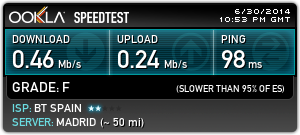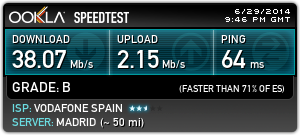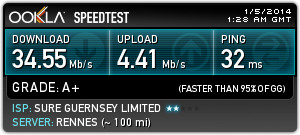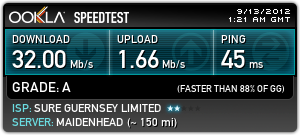In this blog post, 4G = LTE, and not any variant of HSPA…
I have been on O2’s 4G tariff since they launched it back in August, and at the time I knew that their coverage was limited to just a few large cities, but I took the tariff in the hope that they would commence an “aggressive rollout“. Now almost 7 months into the rollout of O2’s 4G network (as well as Vodafone & Three, for that matter), their 4G city coverage is still extremely limited and doesn’t appear to have grown that much. I understand that 4G rollout is just that, a “rollout” that happens over a period of time, but surely when you are trying to play catch-up to the likes of EE (who have far, far superior 4G coverage, albeit due to their massive time advantage), you would think both O2 and Vodafone would be pushing to get 4G to as many cities and towns across the UK as quickly possible.
Now, I might be seeing this entirely wrong, but it seems that O2 in particular have really been pushing their 4G rollout in the north of the country more so than in the south. Not that this is a bad thing, but I would’ve expected a balance of north/south cities to receive 4G in order to get as wide geographic coverage as possible. A list of examples that have yet to receive O2 4G in the southern half of the country, include but are not limited to: Bristol, Southampton, Portsmouth, Oxford, Luton, Milton Keynes.. The list goes on.
In comparison (and I do indeed realise this is very unscientific), cities in the north that have O2 4G coverage (not withstanding Manchester, Liverpool, Leeds) are: York, Newcastle, Nottingham & Sheffield.
In terms of population, the Portsmouth/Southampton area is the 6th highest population in the country, yet it gets no O2 4G as of writing. Bristol, with a population of 600,000, has no O2 4G, yet Sheffield with a similar population already has it.
However, none of the geographic issues actually matter that much when we look at the rollout of Three, the UK’s ‘4th’ mobile operator. Even though they had a later start, and you would think far less cash lying around compared with O2 (Telefonica) and Vodafone, their 4G rollout appears to have been much more aggressive and widespread. Bristol? Check. Oxford? Check. Southampton? Check. Portsmouth? Check. Milton Keynes? Check. Luton? Check…
Three’s rollout, ignoring the numbers, seems more balanced around getting 4G to areas of high population compared with Vodafone and O2. Now, unlike O2, Three has no obligation to deploy their 4G network any further than this, compared with O2’s coverage obligation to cover pretty much the entire country’s population. So this could be a factor, O2 are perhaps pacing themselves and deploying to random rural areas in small pockets (if you look at their coverage checker, there are some rural location masts that have 4G already) rather than deploying to the cities exclusively like Three has.
However as an O2 customer who is paying through the roof for 4G and living in a major southern city, and not receiving the service, and yet customers on Three can get unlimited data and 4G for no additional cost, to say it annoys me is an understatement! The UK’s rollout of 4G has been diabolically slow compared with other countries, which is a shame since we led the rollout of 3G back in the 00’s. I realise that the slow rollout was caused by regulatory incompetence, but it’s not as if the networks didn’t know 4G was coming? Could they not deploy their new masts and equipment before the awarding of the licences? This must have happened to some degree otherwise London and the other ‘starter’ cities are unlikely to have had 4G when it launched in August.
I now move onto the second part of this blog post, which is looking at 4G provision in Spain. If you have read my previous blog posts, you would see that I have been struggling in the past to get decent internet in a rural location in Spain. 2 Mbps internet on an extremely flakey ADSL line just wouldn’t cut it anymore. The speed wasn’t really the issue, but the constant sync failures and sky-high (150ms average) latency just wasn’t acceptable in the year 2014. Vodafone (Spain) has also begun their 4G rollout in Spain using (I believe) the 2.6/1.8 spectrum, since the 800 spectrum isn’t active until later this year. So imagine my surprise when, I get out a friend’s iPhone with a UK Vodafone SIM in, and discover it has a 4G signal in pretty much the middle of nowhere! Data download was about 30 Mbps down and 15 Mbps up, with around 70 ms latency – this probably because the gateway was in the UK. Ignoring the fact that 4G data roaming on Vodafone actually works , (nil points to O2 for not having this yet – it’s not as if Telefonica, their parent company, owns pretty much all the telecom infrastructure in Spain) I was surprised that I even had 4G signal in my location. According to the coverage checker, there is meant to be zero 4G coverage at all, the nearest transmitter is behind 2 hills and a town. So I imagine the signal is reflecting off something and reaching us. (It’s definitely not coming from our local mast, since that is visible from our house and we only had 2 bars of 4G).
So now my challenge was to get hold of a 4G data sim card in Spain, on a business contract, to make use of their unlimited 4G offer for €49. This is actually impossible – Vodafone in Spain clearly don’t want your custom even if you wave money in front of them. With the endless spaghetti mess of bureaucracy and paperwork and legal shit, it’s no wonder Spain is bankrupt. So the easier solution was to get a PAYG sim card and make use of their 4G PAYG option (Called Vodafone Yu) which offers 1.6GB of data for €20. Although it’s pricey, it has some advantages:
1) It will probably work out cheaper paying 5x€20 in one month when we are in Spain, then to pay €49 per month for a service we aren’t going to use all year round.
2) No paperwork. No bureaucracy. Phew!
So with the PAYG sim on order, I’ll have to update you when I get it and do some speed testing. The plan at the moment is to buy a 4G router with external antenna connectors (Probably Solwise) so I can affix an omni antenna to the roof with a bit of extra gain. Also since 4G is meant to be MIMO, with the right hardware/dual feed antenna, I should be able to get 30-40 Mbps.
So, I’m now in the amusing situation that I can get 4G in a rural location in Spain, on a PAYG sim card, and yet I can’t get 4G on my expensive O2 tariff in a major UK city.
Don’t even get me started about O2’s data roaming policies…




